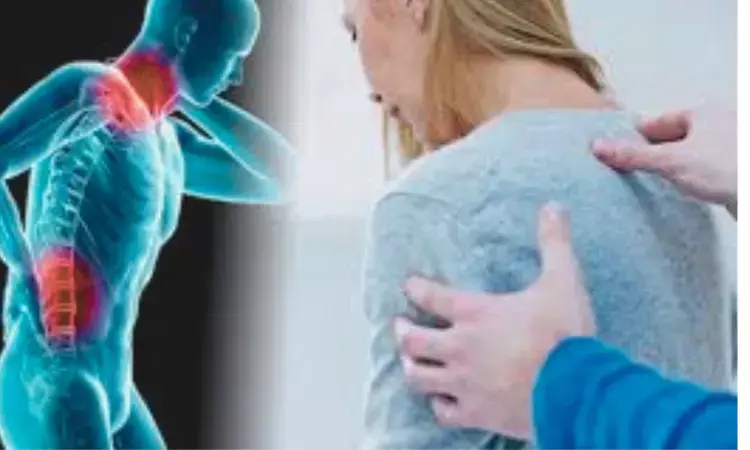- Home
- Medical news & Guidelines
- Anesthesiology
- Cardiology and CTVS
- Critical Care
- Dentistry
- Dermatology
- Diabetes and Endocrinology
- ENT
- Gastroenterology
- Medicine
- Nephrology
- Neurology
- Obstretics-Gynaecology
- Oncology
- Ophthalmology
- Orthopaedics
- Pediatrics-Neonatology
- Psychiatry
- Pulmonology
- Radiology
- Surgery
- Urology
- Laboratory Medicine
- Diet
- Nursing
- Paramedical
- Physiotherapy
- Health news
- Fact Check
- Bone Health Fact Check
- Brain Health Fact Check
- Cancer Related Fact Check
- Child Care Fact Check
- Dental and oral health fact check
- Diabetes and metabolic health fact check
- Diet and Nutrition Fact Check
- Eye and ENT Care Fact Check
- Fitness fact check
- Gut health fact check
- Heart health fact check
- Kidney health fact check
- Medical education fact check
- Men's health fact check
- Respiratory fact check
- Skin and hair care fact check
- Vaccine and Immunization fact check
- Women's health fact check
- AYUSH
- State News
- Andaman and Nicobar Islands
- Andhra Pradesh
- Arunachal Pradesh
- Assam
- Bihar
- Chandigarh
- Chattisgarh
- Dadra and Nagar Haveli
- Daman and Diu
- Delhi
- Goa
- Gujarat
- Haryana
- Himachal Pradesh
- Jammu & Kashmir
- Jharkhand
- Karnataka
- Kerala
- Ladakh
- Lakshadweep
- Madhya Pradesh
- Maharashtra
- Manipur
- Meghalaya
- Mizoram
- Nagaland
- Odisha
- Puducherry
- Punjab
- Rajasthan
- Sikkim
- Tamil Nadu
- Telangana
- Tripura
- Uttar Pradesh
- Uttrakhand
- West Bengal
- Medical Education
- Industry
Home-Based Brain Stimulation Promising in Easing Fibromyalgia Symptoms: JAMA Study

Brazil: A new randomized clinical trial published in JAMA Network Open highlights the potential of home-based, self-administered transcranial direct current stimulation (tDCS) as an effective approach to reducing fibromyalgia-related symptoms.
Conducted by Dr. Wolnei Caumo and colleagues at the Laboratory of Pain and Neuromodulation, Hospital de Clínicas de Porto Alegre, Brazil, the study explored whether anodal tDCS (A-tDCS) targeting the left dorsolateral prefrontal cortex (DLPFC), when combined with exercise and pain neuroscience education (PNE), could yield greater benefits than a placebo treatment.
"The findings suggest that combining A-tDCS with exercise and pain neuroscience education offers an effective strategy for managing fibromyalgia and provides insights into the placebo effects linked to tDCS," the researchers wrote.
Fibromyalgia, a chronic pain disorder predominantly affecting women, is often difficult to treat due to its complex nature and varied symptoms. While smaller previous studies suggested that A-tDCS could be beneficial, questions remained about the duration of its effects and its interaction with other non-pharmacological strategies, such as physical activity and education about pain.
To address this, the double-blind trial enrolled 112 women aged 18 to 65 years diagnosed with fibromyalgia. Participants were randomly assigned to receive either active A-tDCS or sham stimulation over four weeks. Both groups also engaged in a home-based exercise routine and received structured PNE via video sessions. The tDCS intervention involved 20-minute sessions using prefrontal electrodes, with remote monitoring following initial in-person training.
The study assessed changes in pain-related disability using the Multidimensional Pain Interference Index (MPII), which evaluates the impact of pain on everyday activities, emotions, and social engagement. Follow-ups were conducted immediately after treatment and again three months later.
The key findings were as follows:
- MPII scores dropped by 38.76% in the A-tDCS group, compared to a 16.08% reduction in the sham group.
- 62.5% of participants receiving A-tDCS showed a 50% or greater improvement in MPII scores, versus 37.5% in the sham group.
- A-tDCS demonstrated consistent benefits regardless of baseline placebo response.
- Among placebo responders, MPII scores fell by 34.21% with A-tDCS compared to 18.13% with sham treatment.
- In placebo nonresponders, A-tDCS led to a 35.49% reduction in MPII scores, while sham stimulation showed a 25.96% decrease.
These results suggest that the combined approach of brain stimulation, physical activity, and education can effectively reduce both pain severity and related disability in fibromyalgia patients, with effects extending beyond placebo influence.
The authors concluded, "The study reinforces the therapeutic value of A-tDCS and emphasizes the importance of accessible, at-home treatment options for chronic pain conditions. As researchers continue to unravel the role of brain stimulation in pain management, such findings pave the way for more personalized and practical strategies in fibromyalgia care."
Reference:
Caumo W, Franca BR, Orzechowski R, et al. Home-Based Transcranial Direct Current Stimulation vs Placebo for Fibromyalgia: A Randomized Clinical Trial. JAMA Netw Open. 2025;8(6):e2514262. doi:10.1001/jamanetworkopen.2025.14262
Dr Kamal Kant Kohli-MBBS, DTCD- a chest specialist with more than 30 years of practice and a flair for writing clinical articles, Dr Kamal Kant Kohli joined Medical Dialogues as a Chief Editor of Medical News. Besides writing articles, as an editor, he proofreads and verifies all the medical content published on Medical Dialogues including those coming from journals, studies,medical conferences,guidelines etc. Email: drkohli@medicaldialogues.in. Contact no. 011-43720751


